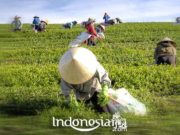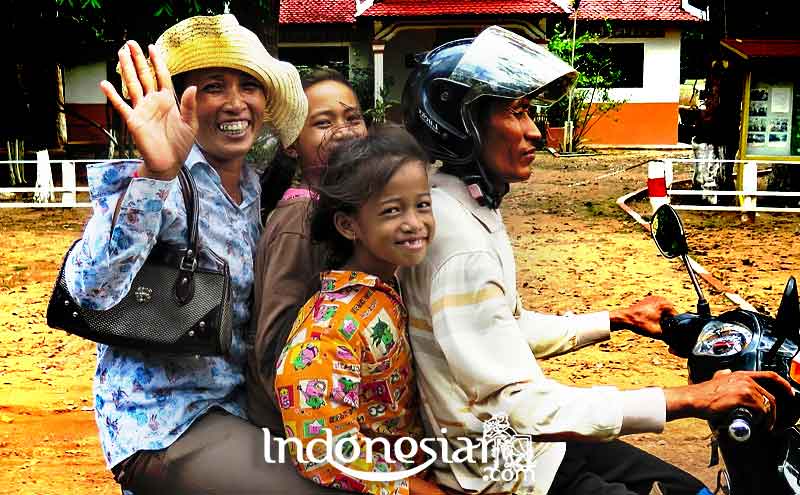Clan for the Raja Ampat people in West Papua is not just a family name. The name of the clan also shows respect for other living things that live on earth. In other words, the consequence of bearing a certain clan means also feeling the impact. In fact, just seeing prohibited marine animals is cheerful. This is the story of mythology as well as nature conservation in Misool, which unfortunately is getting eroded over time.
Approximately 3.5 years ago, one afternoon in mid-2014, at the jetty of Kapatcol Village, West Misool District, Raja Ampat, West Papua, Muhammad Jen Weul (38) was getting ready to run the ship. Suddenly, a colleague shouted, asking him to put a fish given by residents onto the ship.
He was scared to see the fish. Barracuda. The fish he dreaded.
Sorry, I’m holding. There is no other purpose, ”he asked permission, then held the predatory fish. Unfortunately, he was in a rush as he tried to put it down. The fish fell from his hand and slammed on the floor of the boat. Woe!
His mind began to feel uneasy. However, he tried to stay relaxed and brought the boat back to his workplace in Kampung Harapan Jaya, 1 hour away by boat. What he feared proved true. In the afternoon, his body started shivering. Hot-cold there is no cause. Past maghrib, he started babbling.
“I felt numb. After that, I didn’t realize it. Lastly remember, I was appointed by friends. When I wake up at home. In fact, just this afternoon I was still on another island, ”said this resident of Kampung Fafanlap.
Jen then linked her pamali with barracuda. He has a bloodline closely related to the fish. Although he bears the Weul clan, there is also the blood of the Macab family, from his mother’s family line. Since childhood, he also lived with his maternal grandmother who always reminded him of the barracuda pamali.
“Just realized it was night anyway. After I was given drinking water that had been talked about, ”said Jen.
The story is no different from the one told by Harun Loji (30), also a resident of Fafanlap Village. The Loji clan has pamali with sharks and groupers. No need to hold, just looking at the sea, the descendants of this clan immediately feel “good luck”.
Fafanlap Village.
Since childhood, said Harun, he has been warned not to approach, disturb, let alone eat these animals. Until one day, he saw a shark in the waters from the edge of the island. When he came home, he suddenly shivered. Chills.
“Su’s house people know that when they run out of pamalinya. There are people who have migraines or toothaches, but they don’t get well, they must have seen or handled Pamali, “said Harun. “It’s the same if someone is itching like scabies, it is definitely the wrong meal. He ate his pamalinya, “he continued the story.
In some cases, this clan relationship with the pamalinya is considered extreme. Eating cooking oil previously used for frying prohibited fish, for example, will have a bad impact.
In the past, the island was used by a number of shark hunters to take shelter and share the proceeds during the hunting season.
In fact, there are those who do not have a direct connection with a clan, but also undergo pamali. “My wife is not from here (Misool). However, after only three days of marriage, he was already itching. Now they are often possessed by sharks or groupers, ”said Abu Loji with a laugh.
“The medicine is given water, it’s healed already,” he said. The water referred to is water specially formulated from elders in the clan. Only with betel nut offerings, “by the way” to the ancestors, then the offerings are thrown into the sea. The elders will take a mug of sea water and drink it to the sick offspring. And, cling, guaranteed a cure, he claims.
Mythology and conservation
In Misool, it is not only the Loji and Macab clans that have pamali. Call it the Wainsaf clan with barracuda fish pamali, the Umbalak clan with pampang fish, the Soltif clan which pamali prawns and mackerel, or the Iba clan which pamali sharks. Several other tribes are opposed to the turtle or lobster.
Several clans in other villages in Misool have pamali with the sea as well as with plants on land. In Folley Village, West Misool District, there are those who abstain from certain sago or fruit.
The existence of scattered karst hills and forming certain formations attracts tourists, in addition to their underwater beauty.
Jen said, from the story of her parents and grandmother, the pamali existed because of her family’s close experience with barracuda fish. “Maybe I was helped before, so I swore never to eat again. Or maybe they also know that fish is important so they give it a pamali. I don’t know which one is true, but I felt the punishment myself, ”he said.
Belief in certain totems, such as types of fish, is not only found in Misool. In other places in Papua it is found. The Marind-anim (Merauke) people believe in certain totems which are related to the nature around them. Each clan has its own totem.
For example, the Gebze clan which has the coconut totem. This means they will conserve the earth, soil, rocks, and all the animals that are in symbiosis with coconut. There are clans that have cassowary, sago totems, and even musamus (termites). Their totem must be guarded, must not be extinct, because its extinction means the collapse of their existence.
Anthropology lecturer at the Faculty of Letters and Culture, University of Papua, Manokwari, George Minister of Agriculture, said that traditionally, the totem exists throughout the archipelago. However, what distinguishes is the term and the ecology in question.
In Papua, there are four ecological classifications, namely highlands, cliffs, lowlands, and fringes or islands. “For the periphery, of course close to marine animals, beaches, or headlands. In mythology, there used to be events closely related to sharks, groupers or turtles. Logically, there may be allergies or things that are not good for health if you eat certain animals, “said George, who discussed a lot about local wisdom and its relation to natural preservation in Papua.
In essence, continued George, local wisdom related to totems leads to efforts to maintain stable ecosystems. Such wisdom should continue to be applied in ongoing conservation efforts in Misool and Raja Ampat in general. Misool is a part of Raja Ampat with high biodiversity. This archipelago has 1,318 species of reef fish and 533 types of hard corals.
The diversity of marine life at this dive point attracts tourists.
Unfortunately, efforts to aggregate local wisdom with modern conservation have not been maximal. In fact, emphasizing both of them can have an impact on conservation efforts that are easier and cheaper.
In the field, it is evident that the hunting of sharks, turtles and other protected animals by the local community, or outsiders, is still ongoing. Moreover, currently monitoring in Misool, which is part of the Regional Water Conservation Area, has not been running for four months due to operational costs.
The people of Misool have long taught us to love nature and its contents. Majaga tin batan, macinta tin batan, said the elder. “Keeping us has nature, loving we have nature”. That is their good teaching.
Source : kompas
































